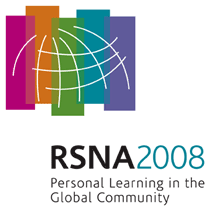
Abstract Archives of the RSNA, 2008
Kelly Powers, Presenter: Nothing to Disclose
Michael David Beland MD, Abstract Co-Author: Nothing to Disclose
William W. Mayo-Smith MD, Abstract Co-Author: Research support, General Electric Company
Research support, Bracco Group
Absolute Hounsfield unit measurements have been used to characterize lesions during CT scans. Prior phantom studies have shown that significant variability exists in the measurement of Hounsfield units. The purpose of this project was to measure the density of a sterile water phantom on multi-phase contrast-enhanced abdominal MDCT exams to determine variability in the density measurement of water (which should theoretically be zero Hounsfield units).
This retrospective study received institutional IRB approval and is HIPAA compliant. 29 consecutive patients undergoing multiphase intravenous contrast-enhanced MDCT scans of the abdomen had a sealed bottle of500 mL sterile water placed on their anterior abdomen during the exam. The density of the water during the non-contrast, arterial and portal venous phase (three-phase liver and renal, pancreatic and abdominal CTA protocols), or non-contrast and delayed phase (hematuria protocol) imaging was measured using an electronic region of interest (ROI). Ten patients were imaged on a 64-detector row scanner (General Electric, VCT), and nineteen were imaged on a 16-detector row scanner (General Electric, Lightspeed 16). Mean density measurements and standard deviation at each phase was calculated. In addition, enhancement for each phase (arterial enhancement = ROI enhanced– ROI unenhanced ) was calculated for each patient. A paired t-test was used to assess for differences between each phase.
Mean values, range and standard deviations (SD) were as follows: Non-contrast mean -3.16, range -22.20 to 27, SD 9.29 HU; early phase mean -3.78, range -23 to 13.60, SD 7.01 HU; delayed phase mean -3.72, range –19.40 to 30.50, SD 9.5 HU. Average arterial enhancement was 0.73 HU (range –13.4 to 17.7 HU). Average portal venous enhancement was 0.27 HU (range –9.5 to 16.2 HU).
There is significant variability in the real-time measurement of water among different patients, with the value of sterile water ranging from –23 to 30.5.Despite variability of HU measurements of the phantom between patients, there was not significant pseudoenhancement demonstrated on arterial and portal venous phase imaging.
Despite daily calibration of CT scanners, the value of “zero” varies widely across multiple phases and from patient to patient which may create significant issues with interpretation of lesions.
Powers, K,
Beland, M,
Mayo-Smith, W,
Is It Really Zero? Variability of Sterile Water Density Measurements during Multiphase Contrast-enhanced MDCT. Radiological Society of North America 2008 Scientific Assembly and Annual Meeting, February 18 - February 20, 2008 ,Chicago IL.
http://archive.rsna.org/2008/6020733.html

